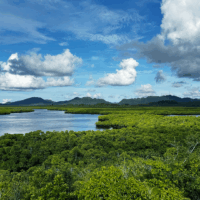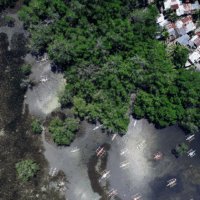Restore Mangrove Forests
Restore Mangrove Forests
SHARE TO SHOW YOUR SUPPORT:
Overview
The Philippines is an archipelagic country with about 18,000 km (about 11184.68 mi) of shorelines and vast areas of mangroves totaling 500,000 hectares in the early 1900s. Unfortunately, over 50% of these mangroves have been lost, primarily due to fishpond conversion and other coastal projects. This has led to the country being ranked as the second worst country in Southeast Asia in terms of mangrove losses.
Mangrove ecosystems are crucial for many coastal communities as they provide livelihood opportunities, food sources, and protection against coastal hazards. Given the country’s longest coastlines, which serve as pathways for tropical cyclones coming from the Pacific Ocean, mangroves and beach forests offer sustainable and cost-efficient ways for fishers and rural communities to protect themselves, their properties, and communities from the devastating impacts of natural disasters. Additionally, mangroves play an essential role on a global scale in stabilizing the climate as they have significant carbon storage and sequestration potential considered to be greater than that of tropical forests.
Despite its critical importance, mangroves remain undervalued and severely threatened. These forests face a multitude of challenges from all fronts- deforestation, land development, reclamation, pollution, conversion of mangroves to fishponds, on the one hand, and climate change and associated sea level rise on the other. Improper planting practices, frequent occurrence of stronger typhoons, and weak enforcement have further hindered mangrove conservation efforts.
Recognizing the importance of mangroves and the threats they face; Oceana officially launched its campaign to restore mangrove forest areas in the Philippines in 2022. The goal of the campaign is to secure the approval of a national law to facilitate the restoration and preservation of mangroves and beach forests to combat coastal erosion and mitigate the adverse effects of climate change.
A year after, the House of Representatives passed unanimously House Bill No. 7767 on May 22, 2023. These mandates integrated coastal management as a national strategy for the holistic and sustainable management of coastal and related ecosystems, establishing the national coastal greenbelt action plan, and introducing supporting mechanisms for its implementation, including the allocation of funds.
If the Senate passes its counterpart bill, this will lead to the institutionalization and integration of currently fragmented mangrove conservation policies. By aligning efforts and resources, the bill sets the stage for significant improvements in the management and protection of mangroves, ultimately benefiting both the environment and the communities that rely on these vital ecosystems.
Four (4) Senators have sponsored separate bills for the establishment of coastal greenbelt zones in the country:
- SB 113 (Establishing the National Coastal Greenbelt Plan) filed by Sen. Nancy Binay
- SB 591 (National Coastal Greenbelt Program) filed by Sen. Risa Hontiveros
- SB 1117 (Establishing the National Coastal Greenbelt Zones and National Coastal Greenbelt Management Action Plan) filed by Sen. Loren Legarda
- SB 1237 (Establishing the National Coastal Greenbelt Zones and National Coastal Greenbelt Management Action Plan) filed by Sen. Cynthia Villar
If passed, the National Coastal Greenbelt Law will provide the overarching framework and general guiding principles for implementing a science-based and cost-effective program to protect, restore and manage mangrove resources. With this law, appropriate agencies and government instrumentalities will have clearly defined mandates, standards, targets, and resources to implement and operationalize plans for the establishment and management of coastal greenbelt zones around the country.



